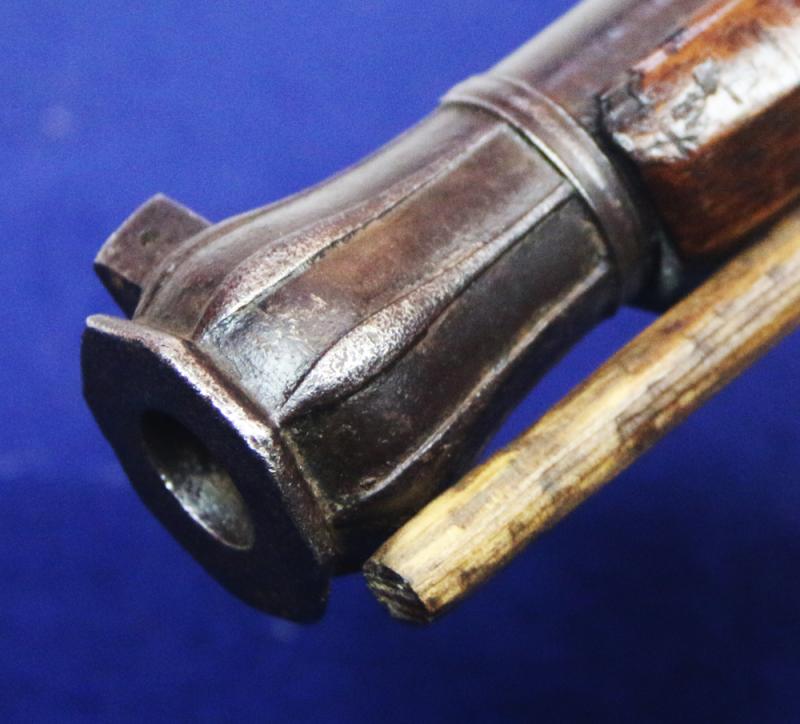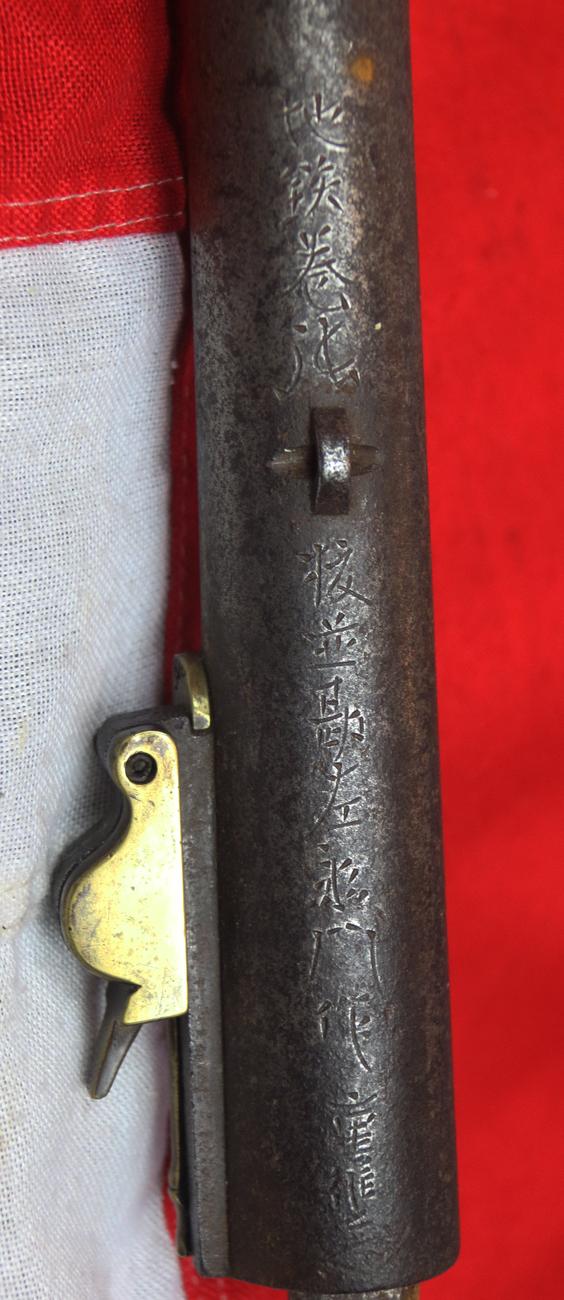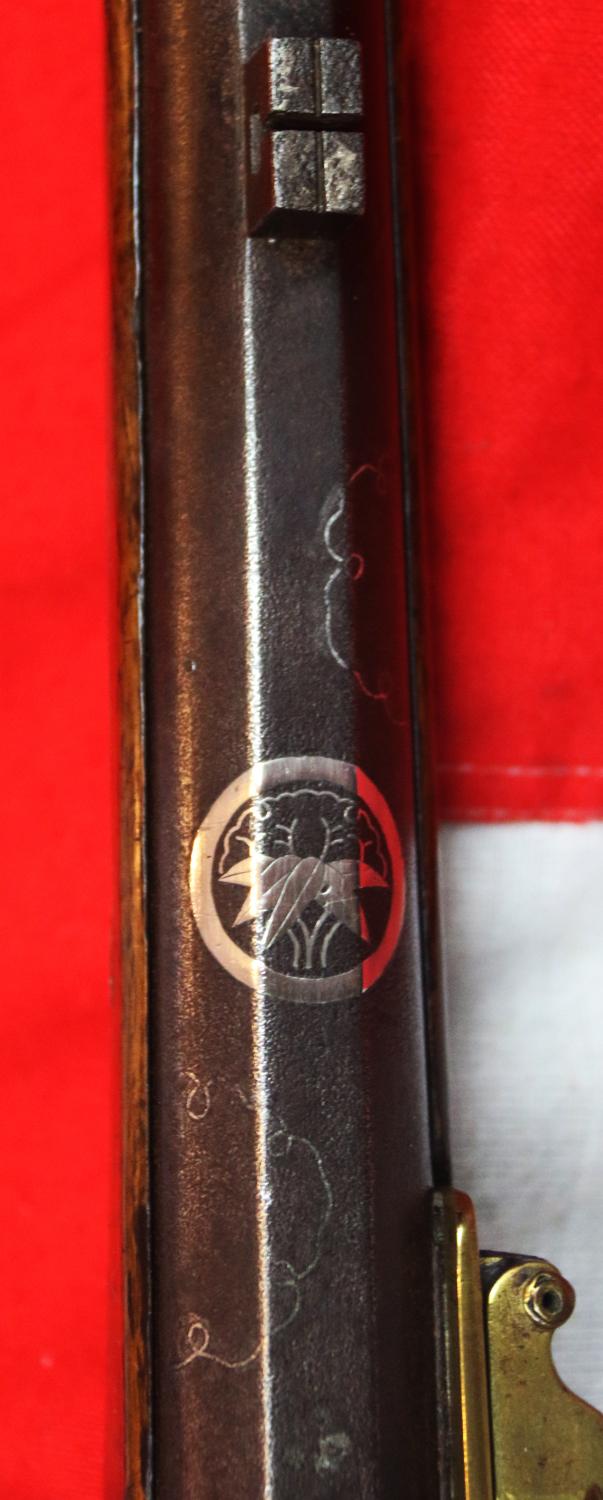A Superb Edo Period Samurai Teppo {Arquebus Musket} With Signed Barrel Bearing the Silver Clan Mon of the Minamoto. One of The Greatest Clans of Samurai History
A beautiful museum quality piece. A fine original long Samurai tanegashima musket from the Edo period 1598-1868, the barrel is signed underneath with the gunmaking family name. The barrel has a silver inlaid mon, engraved with the kamon of the Minamoto clan of Japan, on the top section of the barrel is futher silver inlays of clouds.
Kamakura period and Kamakura city, which were established and founded by Minamoto no Yoritomo—the first shōgun of Japan.
Muromachi period was founded by shōgun Ashikaga Takauji—a direct descendant of Minamoto no Yoshiyasu (also known as Ashikaga Yoshiyasu).
Edo period was founded by shōgun Tokugawa Ieyasu—who claimed to be a descendant of Minamoto no Yoshishige (also known as Nitta Yoshishige).
The Tokugawa Shoguns ruled Japan for more than two centuries. The type of weapon most often called in Japanese, and sometimes in English Hinawaju, which means matchlock gun. It was a type of matchlock configured arquebus firearm. Clan mon motif of Sasarindo stylized gentian plants combined with bamboo leaves
The Samurai's teppo has been used in Samurai Warfare since their introduction to the Samurai, in 1543, by the Portugese. Much of Japan was involved with internecine wars during the Sengoku period (1467-1603), as feudal lords vied for supremacy.
Matchlock guns were introduced midway through the period and saw extensive use in the later years of the conflict, playing a decisive role on the battlefield. In 1549, Oda Nobunaga ordered 500 guns to be produced for his armies at a time when the benefits of firearms over traditional weapons were still relatively questionable to other daimyo.
The Japanese soon worked on various techniques to improve the effectiveness of their guns. They developed a staggered firing technique to create a continuous rain of bullets on the enemy. They also developed larger calibre barrels and ammunition to increase lethality. Protective boxes in lacquerware were invented to fit over the firing mechanism so it could still fire while it was raining, as were systems to accurately fire weapons at night by keeping fixed angles thanks to measured strings. Another development would be the hayago, a bamboo cartridge used to facilitate faster reloading. A hollow tube open on the both ends, the hayago contained gun powder, wadding, and a bullet. Upon tearing open the tube's paper seal at the bottom, a soldier could quickly use it to pour the necessary powder into his weapon before placing over the barrel and using his rammer to load both wadding and bullet into the barrel at the same time. After use, the hayago could be kept for repacking or discarded.
One significant place to see other original Samurai Tanegeshima in present day Japan is in Matsumoto Castle, within their armoury. Particular importance in the collection are the Tanageshima, which played an important role during the massive battle for Osaka Castle in 1615. The main articles in the collection are matchlocks manufactured in the period from 1543 (when guns were introduced by the Portuguese through Tanegashima island) through to the late Edo period during the long Tokugawa peace. In total there are 141 guns of different design, calibre and period, and 230 pieces of armour. All of the weapons were made in Japan during a century in which enormous changes took place, both in Japan's social and political organization and modernisation prior to the closing of the country and 250 years of relative isolation. Matsumoto Castle was built some 50 years after the introduction by Portuguese traders of firearms into Japan. For this reason the walls of the turrets (Nurigome-zukuri) are thick enough to withstand bullets, and the defences were built in depth. As firearms were also used to defend the castle, the donjon has 55 square holes called teppozama, from which matchlock muskets (and in some cases small cannon) could bring fire to bear on an assaulting force
Code: 25297










